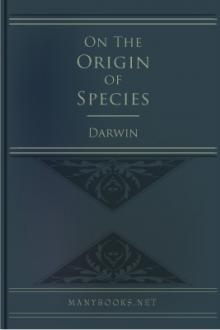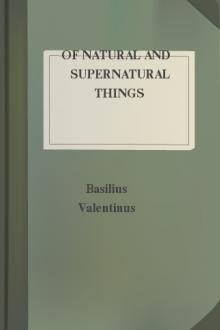The Origin of Species by means of Natural Selection (6th ed), Charles Darwin [the beginning after the end read novel .TXT] 📗

- Author: Charles Darwin
- Performer: -
Book online «The Origin of Species by means of Natural Selection (6th ed), Charles Darwin [the beginning after the end read novel .TXT] 📗». Author Charles Darwin
Some birds build their nests of mud, believed to be moistened with saliva; and one of the swifts of North America makes its nest (as I have seen) of sticks agglutinated with saliva, and even with flakes of this substance.
Is it then very improbable that the natural selection of individual swifts, which secreted more and more saliva, should at last produce a species with instincts leading it to neglect other materials and to make its nest exclusively of inspissated saliva? And so in other cases. It must, however, be admitted that in many instances we cannot conjecture whether it was instinct or structure which first varied.
No doubt many instincts of very difficult explanation could be opposed to the theory of natural selection—cases, in which we cannot see how an instinct could have originated; cases, in which no intermediate gradations are known to exist; cases of instincts of such trifling importance, that they could hardly have been acted on by natural selection; cases of instincts almost identically the same in animals so remote in the scale of nature that we cannot account for their similarity by inheritance from a common progenitor, and consequently must believe that they were independently acquired through natural selection. I will not here enter on these several cases, but will confine myself to one special difficulty, which at first appeared to me insuperable, and actually fatal to the whole theory. I allude to the neuters or sterile females in insect communities: for these neuters often differ widely in instinct and in structure from both the males and fertile females, and yet, from being sterile, they cannot propagate their kind.
The subject well deserves to be discussed at great length, but I will here take only a single case, that of working or sterile ants. How the workers have been rendered sterile is a difficulty; but not much greater than that of any other striking modification of structure; for it can be shown that some insects and other articulate animals in a state of nature occasionally become sterile; and if such insects had been social, and it had been profitable to the community that a number should have been annually born capable of work, but incapable of procreation, I can see no especial difficulty in this having been effected through natural selection. But I must pass over this preliminary difficulty. The great difficulty lies in the working ants differing widely from both the males and the fertile females in structure, as in the shape of the thorax, and in being destitute of wings and sometimes of eyes, and in instinct. As far as instinct alone is concerned, the wonderful difference in this respect between the workers and the perfect females would have been better exemplified by the hivebee.
If a working ant or other neuter insect had been an ordinary animal, I should have unhesitatingly assumed that all its characters had been slowly acquired through natural selection; namely, by individuals having been born with slight profitable modifications, which were inherited by the offspring, and that these again varied and again were selected, and so onwards. But with the working ant we have an insect differing greatly from its parents, yet absolutely sterile; so that it could never have transmitted successively acquired modifications of structure or instinct to its progeny. It may well be asked how it is possible to reconcile this case with the theory of natural selection?
First, let it be remembered that we have innumerable instances, both in our domestic productions and in those in a state of nature, of all sorts of differences of inherited structure which are correlated with certain ages and with either sex. We have differences correlated not only with one sex, but with that short period when the reproductive system is active, as in the nuptial plumage of many birds, and in the hooked jaws of the male salmon. We have even slight differences in the horns of different breeds of cattle in relation to an artificially imperfect state of the male sex; for oxen of certain breeds have longer horns than the oxen of other breeds, relatively to the length of the horns in both the bulls and cows of these same breeds. Hence, I can see no great difficulty in any character becoming correlated with the sterile condition of certain members of insect communities; the difficulty lies in understanding how such correlated modifications of structure could have been slowly accumulated by natural selection.
This difficulty, though appearing insuperable, is lessened, or, as I believe, disappears, when it is remembered that selection may be applied to the family, as well as to the individual, and may thus gain the desired end. Breeders of cattle wish the flesh and fat to be well marbled together. An animal thus characterized has been slaughtered, but the breeder has gone with confidence to the same stock and has succeeded. Such faith may be placed in the power of selection that a breed of cattle, always yielding oxen with extraordinarily long horns, could, it is probable, be formed by carefully watching which individual bulls and cows, when matched, produced oxen with the longest horns; and yet no one ox would ever have propagated its kind. Here is a better and real illustration: According to M. Verlot, some varieties of the double annual stock, from having been long and carefully selected to the right degree, always produce a large proportion of seedlings bearing double and quite sterile flowers, but they likewise yield some single and fertile plants. These latter, by which alone the variety can be propagated, may be compared with the fertile male and female ants, and the double sterile plants with the neuters of the same community. As with the varieties of the stock, so with social insects, selection has been applied to the family, and not to the individual, for the sake of gaining a serviceable end. Hence, we may conclude that slight modifications of structure or of instinct, correlated with the sterile condition of certain members of the community, have proved advantageous; consequently the fertile males and females have flourished, and transmitted to their fertile offspring a tendency to produce sterile members with the same modifications. This process must have been repeated many times, until that prodigious amount of difference between the fertile and sterile females of the same species has been produced which we see in many social insects.
But we have not as yet touched on the acme of the difficulty; namely, the fact that the neuters of several ants differ, not only from the fertile females and males, but from each other, sometimes to an almost incredible degree, and are thus divided into two or even three castes. The castes, moreover, do not generally graduate into each other, but are perfectly well defined; being as distinct from each other as are any two species of the same genus, or rather as any two genera of the same family. Thus, in Eciton, there are working and soldier neuters, with jaws and instincts extraordinarily different: in Cryptocerus, the workers of one caste alone carry a wonderful sort of shield on their heads, the use of which is quite unknown: in the Mexican Myrmecocystus, the workers of one caste never leave the nest; they are fed by the workers of another caste, and they have an enormously developed abdomen which secretes a sort of honey, supplying the place of that excreted by the aphides, or the domestic cattle as they may be called, which our European ants guard and imprison.
It will indeed be thought that I have an overweening confidence in the principle of natural selection, when I do not admit that such wonderful and well-established facts at once annihilate the theory. In the simpler case of neuter insects all of one caste, which, as I believe, have been rendered different from the fertile males and females through natural selection, we may conclude from the analogy of ordinary variations, that the successive, slight, profitable modifications did not first arise in all the neuters in the same nest, but in some few alone; and that by the survival of the communities with females which produced most neuters having the advantageous modification, all the neuters ultimately came to be thus characterized. According to this view we ought occasionally to find in the same nest neuter-insects, presenting gradations of structure; and this we do find, even not rarely, considering how few neuter-insects out of Europe have been carefully examined. Mr. F. Smith has shown that the neuters of several British ants differ surprisingly from each other in size and sometimes in colour; and that the extreme forms can be linked together by individuals taken out of the same nest: I have myself compared perfect gradations of this kind. It sometimes happens that the larger or the smaller sized workers are the most numerous; or that both large and small are numerous, while those of an intermediate size are scanty in numbers.
Formica flava has larger and smaller workers, with some few of intermediate size; and, in this species, as Mr. F. Smith has observed, the larger workers have simple eyes (ocelli), which, though small, can be plainly distinguished, whereas the smaller workers have their ocelli rudimentary.
Having carefully dissected several specimens of these workers, I can affirm that the eyes are far more rudimentary in the smaller workers than can be accounted for merely by their proportionately lesser size; and I fully believe, though I dare not assert so positively, that the workers of intermediate size have their ocelli in an exactly intermediate condition.
So that here we have two bodies of sterile workers in the same nest, differing not only in size, but in their organs of vision, yet connected by some few members in an intermediate condition. I may digress by adding, that if the smaller workers had been the most useful to the community, and those males and females had been continually selected, which produced more and more of the smaller workers, until all the workers were in this condition; we should then have had a species of ant with neuters in nearly the same condition as those of Myrmica. For the workers of Myrmica have not even rudiments of ocelli, though the male and female ants of this genus have well-developed ocelli.
I may give one other case: so confidently did I expect occasionally to find gradations of important structures between the different castes of neuters in the same species, that I gladly availed myself of Mr. F. Smith’s offer of numerous specimens from the same nest of the driver ant (Anomma) of West Africa. The reader will perhaps best appreciate the amount of difference in these workers by my giving, not the actual measurements, but a strictly accurate illustration: the difference was the same as if we were to see a set of workmen building a house, of whom many were five feet four inches high, and many sixteen feet high; but we must in addition





Comments (0)